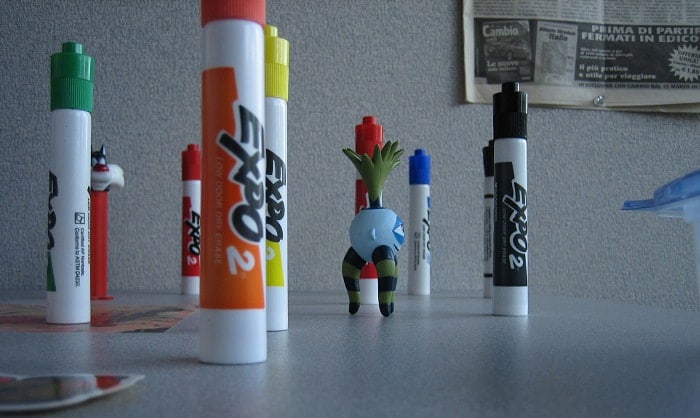With the expansion of digital note-taking, some people may think that writing is out-of-date. However, it is still a pleasure to note something on the paper or board using pens, paintbrushes, or even expo markers.
Have you ever wondered why dry erase marker ink can appear on whatever surfaces we draw them on? Have you ever searched through books and the Internet to find out how this phenomenon happens?
If so, then this article is for you! We are going to give you the most thorough and detailed answer to the question “How do dry erase markers work?”. In short, it can be explained by the components of dry erase marker ink.
Without further ado, let’s discover the real science behind this phenomenon.
Table of Contents
What is Inside
Similar to other kinds of markers, dry erase markers ink is made of three main ingredients: a carrier, color pigments, and resin, or release agent. Depending on the design of the markers, some may have a cap to prevent the ink from being dried out.
A carrier, or so-called a solvent, is essential in carrying out the ink to the surface. Its mission is to prevent smudging and help the ink dry. For a dry erase marker, the purpose of the carrier is to stick the ink together, not to the surface.
In the past, people used benzene as a carrier for their first-ever dry erase markers, which were rather toxic. Nowadays, manufacturers prefer using alcohol-based solvents, such as ethanol and isopropanol. These alternatives are less toxic and don’t create any stinks.
Next are color pigments. The ingredient adds a little touch to the color of the marker that we use. Thanks to the variety of colors, artists can be creative and express their brilliant thoughts in the most colorful ways.
The last component is the release agent, usually resin or polymer, whose job is to help the ink adhere to the surface nicely and evenly.
For a permanent marker, manufacturers use an acrylic polymer to keep the ink stay on the surface. However, the type of polymer used to make dry erase markers is oily silicone polymer. Hence, dry erase marker ink does not stick to the surface and can easily be wiped out once the alcohol has evaporated.
By putting together these ingredients in a precise predetermined proportion, dry erase markers can be produced to serve our purposes. Now that we’ve discovered dry erase marker ink components, we can move on to find out the mechanics of dry erase markers.
How Dry Erase Markers Work
Dry erase marker is undeniably one of the most convenient markers thanks to its ability to be erased easily on any surface. But first, let’s look at how the ink appears on the surface.
- The dry erase marker ink adheres to the surface when writing as well as the alcohol solvents evaporate.
- When you want to get rid of dry erase markers you have written, simply wipe it out by using a whiteboard eraser, a piece of paper, or a cloth.
Nonetheless, why does the dry erase marker ink can be erased so easily compared to other types of markers? Well, it’s all due to the magical ingredients inside dry erase markers and the polymer science.
First of all, let’s take a look back at what is inside a dry erase marker, whose main ingredient is simply a carrier, colorant, and release agent. Specifically, we should pay attention to the release agent, which is an oily silicone polymer in this case.
Consequently, unlike permanent markers, dry erase marker ink is slippery enough so that it does not stick to the surface. Moreover, the oily polymer stops the dry erase marker ink from interacting with the surface directly, which allows it to be easily wiped off the surface.
Another factor contributing to the marker’s erasability is the writing surface. Normally, dry erase markers are used on non-porous surfaces, such as whiteboards. These surfaces are rather a static charge so the ink can stay on the board but not too much.
As it turns out, the main reason why dry erase markers can be erased easily is polymer science – the oily polymer that makes the ink slippery and keeps the ink from directly contacting the surface.
We can always erase any dry erase marker stains using any readily available household items – paper tissue, a damp cloth, or even an eraser.
Conclusion
It’s always fun to find out what’s behind the curtain. In addition, this explanation also provides some knowledge for us to use our dry erase markers in a better way.
I hope I have presented to you a comprehensive answer to the question “How do dry erase markers work?” Let me know what you think in the comment section. If you are interested in this article, share it with your friends and family to make their day.

I am a former art teacher, so it is evident to me the importance of art in educating the new generation. We also want to help parents who plan to teach their children and desire the best tools and tips for them.

